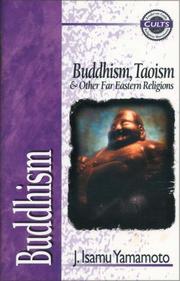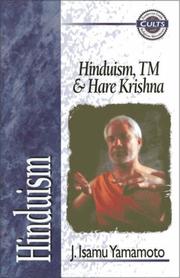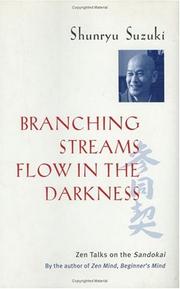| Listing 1 - 10 of 23 | << page >> |
Sort by
|

ISBN: 0310489121 Year: 1998 Publisher: Grand Rapids, Michigan ZonderVan Publishing House
Abstract | Keywords | Export | Availability | Bookmark
 Loading...
Loading...Choose an application
- Reference Manager
- EndNote
- RefWorks (Direct export to RefWorks)
theology --- Eastern philosophy --- Eastern religions --- Buddhism --- Taoism
Book
Abstract | Keywords | Export | Availability | Bookmark
 Loading...
Loading...Choose an application
- Reference Manager
- EndNote
- RefWorks (Direct export to RefWorks)
Book
ISBN: 0710074859 Year: 1972 Publisher: London Routledge and Kegan Paul
Abstract | Keywords | Export | Availability | Bookmark
 Loading...
Loading...Choose an application
- Reference Manager
- EndNote
- RefWorks (Direct export to RefWorks)
Eastern philosophy --- Western psychology --- China --- ancient Chinese text --- meditation
Book
ISBN: 3031399552 3031399544 9783031399558 Year: 2023 Publisher: Cham, Switzerland : Palgrave Macmillan,
Abstract | Keywords | Export | Availability | Bookmark
 Loading...
Loading...Choose an application
- Reference Manager
- EndNote
- RefWorks (Direct export to RefWorks)
The book is a much-expanded version of the Kuang-Yi Liu Lectures in Chinese Philosophy the author delivered in Taiwan in December 2022. The book brings together essays on Chinese philosophy, Western philosophy, and the proposed interaction between them. The purpose is not mainly exegetical or descriptive; the book seeks to expand our philosophical understanding in various directions. Philosophical Essays East and West shows how Chinese thought can help Western analytic philosophy develop further and can even serve as a corrective to certain central aspects of traditional and contemporary Western philosophical thinking. We Western analytic philosophers don’t think we have much if anything to learn from Chinese philosophical ideas. But we do, we do, and much of the present book seeks to show how. Studying topics in ethics, philosophy of mind, epistemology, and aesthetics, this book puts Chinese philosophy in conversation with traditional problems in Western analytic philosophy. It also proposes aphorism as an important method in both traditions. Michael Slote is Professor of Philosophy at the University of Miami (Florida, USA). He is author of over 15 books, and one of the editors of Palgrave Studies in Comparative East-West Philosophy.
Philosophy, Chinese. --- Philosophy. --- Philosophy, Asian. --- Chinese Philosophy. --- Western Philosopy. --- Eastern Philosophy. --- Ethics. --- Philosophy, Comparative.
Book
ISBN: 9783031568749 Year: 2024 Publisher: Cham : Springer Nature Switzerland : Imprint: Palgrave Macmillan,
Abstract | Keywords | Export | Availability | Bookmark
 Loading...
Loading...Choose an application
- Reference Manager
- EndNote
- RefWorks (Direct export to RefWorks)
This book “resonates” the work of Chinese and Western philosophers, developing ontological ideas that are neither purely Chinese nor Western. In so doing, it argues that Deleuzian idea of “resonance” offers a model for a new way of doing comparative philosophy in which the comparison actualizes the virtual and counter-actualizes the actual in both compared traditions. More particularly, Neo-Confucian thinkers Zhang Zai (1020–1077), Zhu Xi (1130–1200), and Wang Yangming (1472–1529) are resonated with Baruch Spinoza (1632–1677), Arthur Schopenhauer (1788–1860), Husserlian phenomenology, and Gilles Deleuze (1925–1995). The three Chinese thinkers represent three distinct currents of Neo-Confucianism: the school of veins (li) of Zhu Xi, the school of energy (qi) of Zhang Zai, the school of mind (xin) of Wang Yangming. The method of resonance is used to discuss the following topics: dichotomy of veins and energy, temporality and subjectivity, self-cultivation, all-embracing energy, dichotomy of primary ability and primary knowledge. Margus Ott received a PhD in philosophy at Tallinn University in 2014. He has an extensive publication record in Estonian, including a series of six books of philosophy, a monograph on Chinese music and divination, and a translation of Zhuangzi's "Inner Chapters". .

ISBN: 0310703913 Year: 1998 Publisher: Grand Rapids, Michigan ZonderVan Publishing House
Abstract | Keywords | Export | Availability | Bookmark
 Loading...
Loading...Choose an application
- Reference Manager
- EndNote
- RefWorks (Direct export to RefWorks)
Hinduism --- TM --- Hare Krishna --- theology --- biblical Christianity --- the Beatles --- the Beach Boys --- Eastern philosophy --- Eastern religions --- North America
Book
ISBN: 3110616807 3110617005 3110616602 Year: 2020 Publisher: De Gruyter
Abstract | Keywords | Export | Availability | Bookmark
 Loading...
Loading...Choose an application
- Reference Manager
- EndNote
- RefWorks (Direct export to RefWorks)
This book explores the relationships between ancient Roman and Confucian thought, paying particular attention to their relevance for the contemporary world. More than 10 scholars from all around the world offer thereby a reference work for the comparative research between Roman (and early Greek) and Eastern thought, setting new trends in the panorama of Classical and Comparative Studies.
Literary studies: classical, early & medieval --- Western philosophy: Ancient, to c 500 --- Cicero. --- Confucius. --- Eastern Philosophy. --- Roman Philosophy. --- Europe --- Korea --- Civilization --- Confucian influences. --- Foreign influences. --- Council of Europe countries --- Eastern Hemisphere --- Eurasia

ISBN: 1282759418 9786612759413 0520932315 1598759167 9780520932319 1423745515 9781423745518 0520246195 9780520246195 9780520246195 0520246195 9781282759411 6612759410 9781598759167 Year: 2006 Publisher: Berkeley University of California Press
Abstract | Keywords | Export | Availability | Bookmark
 Loading...
Loading...Choose an application
- Reference Manager
- EndNote
- RefWorks (Direct export to RefWorks)
This highly original, provocative, and poetic work explores the nexus of time, truth, and death in the symbolic world of medieval kabbalah. Demonstrating that the historical and theoretical relationship between kabbalah and western philosophy is far more intimate and extensive than any previous scholar has ever suggested, Elliot R. Wolfson draws an extraordinary range of thinkers such as Frederic Jameson, Martin Heidegger, Franz Rosenzweig, William Blake, Julia Kristeva, Friedrich Schelling, and a host of kabbalistic figures into deep conversation with one another. Alef, Mem, Tau also discusses Islamic mysticism and Buddhist thought in relation to the Jewish esoteric tradition as it opens the possibility of a temporal triumph of temporality and the conquering of time through time. The framework for Wolfson's examination is the rabbinic teaching that the word emet, "truth," comprises the first, middle, and last letters of the Hebrew alphabet, alef, mem, and tau, which serve, in turn, as semiotic signposts for the three tenses of time-past, present, and future. By heeding the letters of emet we discern the truth of time manifestly concealed in the time of truth, the beginning that cannot begin if it is to be the beginning, the middle that re/marks the place of origin and destiny, and the end that is the figuration of the impossible disclosing the impossibility of figuration, the finitude of death that facilitates the possibility of rebirth. The time of death does not mark the death of time, but time immortal, the moment of truth that bestows on the truth of the moment an endless beginning of a beginningless end, the truth of death encountered incessantly in retracing steps of time yet to be taken-between, before, beyond.
Cabala --- Time --- History. --- Religious aspects --- Judaism. --- Philosophy. --- aqiva. --- azriel of gerona. --- azriel. --- babylonian talmud. --- bahir. --- bahiric text. --- berakhah. --- bereshit. --- binah. --- buddhism. --- death. --- destiny. --- eastern philosophy. --- eastern religion. --- emet. --- esoteric religion. --- immortality. --- islam. --- judaica. --- judaism. --- kabbalah. --- kabbalism. --- medieval kabbalah. --- mysticism. --- nature of time. --- philosophy. --- rebirth. --- religion. --- religious studies. --- semiotics. --- temporality. --- time. --- western philosophy. --- yiddishkeit.

ISBN: 052093623X 1280095008 1597345105 9786613520432 9780520936232 0520219821 9780520219823 9781280095009 9781597345101 6613520438 Year: 1999 Publisher: Berkeley University of California Press
Abstract | Keywords | Export | Availability | Bookmark
 Loading...
Loading...Choose an application
- Reference Manager
- EndNote
- RefWorks (Direct export to RefWorks)
When Shunryu Suzuki Roshi's Zen Mind, Beginner's Mind was published in 1972, it was enthusiastically embraced by Westerners eager for spiritual insight and knowledge of Zen. The book became the most successful treatise on Buddhism in English, selling more than one million copies to date. Branching Streams Flow in the Darkness is the first follow-up volume to Suzuki Roshi's important work. Like Zen Mind, Beginner's Mind, it is a collection of lectures that reveal the insight, humor, and intimacy with Zen that made Suzuki Roshi so influential as a teacher. The Sandokai-a poem by the eighth-century Zen master Sekito Kisen (Ch. Shitou Xiqian)-is the subject of these lectures. Given in 1970 at Tassajara Zen Mountain Center, the lectures are an example of a Zen teacher in his prime elucidating a venerated, ancient, and difficult work to his Western students. The poem addresses the question of how the oneness of things and the multiplicity of things coexist (or, as Suzuki Roshi expresses it, "things-as-it-is"). Included with the lectures are his students' questions and his direct answers to them, along with a meditation instruction. Suzuki Roshi's teachings are valuable not only for those with a general interest in Buddhism but also for students of Zen practice wanting an example of how a modern master in the Japanese Soto Zen tradition understands this core text today.
Zen Buddhism --- Doctrines. --- Sekito Kisen --- Kisen, Sekito --- 1970. --- beauty. --- buddhism. --- buddhist poetry. --- buddhist teachings. --- buddhists. --- collection of lectures. --- eastern philosophy. --- japan. --- japanese buddhism. --- life journey. --- meditation instructions. --- modern buddhism. --- nonfiction. --- oneness. --- philosophy. --- question and answer. --- religious treatise. --- sandokai. --- soto zen tradition. --- spiritual insight. --- spiritualism. --- spirituality and religion. --- students and teachers. --- western students. --- world religions. --- zen buddhism. --- zen masters. --- zen practices. --- zen teachers. --- zen.
Book
ISBN: 1283291770 9786613291776 0520948181 9780520948181 9780520266988 Year: 2011 Publisher: Berkeley University of California Press
Abstract | Keywords | Export | Availability | Bookmark
 Loading...
Loading...Choose an application
- Reference Manager
- EndNote
- RefWorks (Direct export to RefWorks)
A foundation of Chinese life sciences and medicine, the Huang Di Nei Jing Su Wen is now available for the first time in a complete, fully annotated English translation. Also known as Su Wen, or The Yellow Emperor's Inner Classic, this influential work came into being over a long period reaching from the 2nd century bce to the 8th century ce. Combining the views of different schools, it relies exclusively on natural law as conceptualized in yin/yang and Five Agents doctrines to define health and disease, and repeatedly emphasizes personal responsibility for the length and quality of one's life. This two-volume edition includes excerpts from all the major commentaries on the Su Wen, and extensive annotation drawn from hundreds of monographs and articles by Chinese and Japanese authors produced over the past 1600 years and into the twentieth century.
Medicine, Chinese --- Su wen. --- alternative medicine. --- character. --- chinese literature. --- chinese medicine. --- chinese tradition. --- classical chinese medicine. --- disease prevention. --- disease. --- eastern medicine. --- eastern philosophy. --- five agents. --- health and wellness. --- health. --- healthcare. --- huang di nei jing su wen. --- hygiene. --- medicine. --- nonfiction. --- su wen. --- yellow emperor. --- yellow emperors inner classic. --- yin yang.
| Listing 1 - 10 of 23 | << page >> |
Sort by
|

 Search
Search Feedback
Feedback About UniCat
About UniCat  Help
Help News
News